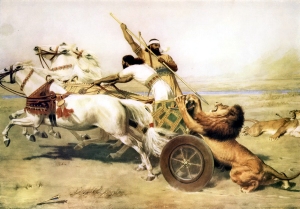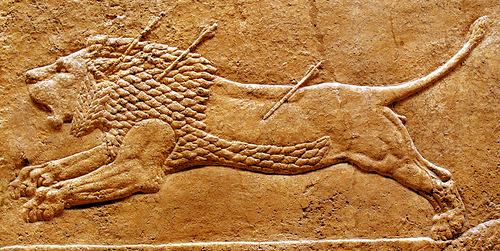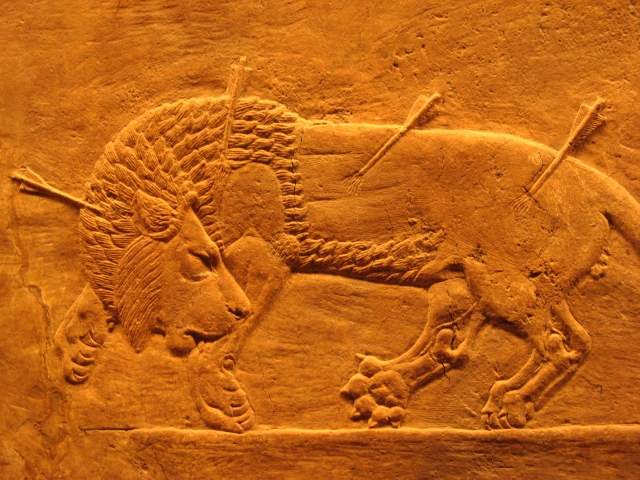What is it:
This is a bas relief panel carved in limestone from an enormous frieze depicting the royal lion hunts of Assyria, built for the North Palace of Nineveh, circa 645-635 BC. It is now on display at the British Museum in London in a massive hall that will take your breath away.
Why is it Awesome?
I first came across the sculpture when I was seventeen, wandering around the British Museum. The lion’s expression of suffering –of great dignity struck low– was so palpable that I felt compelled to sit down and sketch it. I have that drawing taped into one of my early notebooks, and in an idle moment a year or so ago I decided to look around online to see if the image was available. Much to my delight, my very lion –of the dozens depicted on the frieze– was available on the Wikipedia Commons. It promptly became my desktop. I have since scoured the Internet for more images and information with limited results at best, I’m afraid. What I did find is compiled into this article.
 Assyria was the Cradle of Civilization’s first true super power. There had been a great number of powerful city states and confederations before, but it was Assyria who first created a true Mesopotamian Empire in the modern sense. Assyria can be credited with the invention of the first modern, standing army. Their wars of conquest are well-known even today thanks in large part to their many appearances in the Bible. At the time of this frieze’s construction, the Assyrians ruled over the entire Fertile Crescent, the Holy Land, and much of Egypt.
Assyria was the Cradle of Civilization’s first true super power. There had been a great number of powerful city states and confederations before, but it was Assyria who first created a true Mesopotamian Empire in the modern sense. Assyria can be credited with the invention of the first modern, standing army. Their wars of conquest are well-known even today thanks in large part to their many appearances in the Bible. At the time of this frieze’s construction, the Assyrians ruled over the entire Fertile Crescent, the Holy Land, and much of Egypt.
 As might be expected from a powerful militaristic monarchy, the Assyrian Kings were avid hunters when not campaigning. Ashurnasirpal II (king from 883 – 859 BC) claimed in one of his epithets: “I killed 30 elephants with the bow. 257 powerful wild bull I killed them from my war chariot. I killed 370 strong lions just by spear like birds in a cage.”
As might be expected from a powerful militaristic monarchy, the Assyrian Kings were avid hunters when not campaigning. Ashurnasirpal II (king from 883 – 859 BC) claimed in one of his epithets: “I killed 30 elephants with the bow. 257 powerful wild bull I killed them from my war chariot. I killed 370 strong lions just by spear like birds in a cage.”
 While all men and beasts were prey to the Assyrian nobility, lions were the particular sport of kings, symbolizing the ruling monarch’s duty to protect and fight for his people as well as his dominion over everything within his borders. The palace of the new capital at Nineveh was decorated with these sculpted reliefs to illustrate the prowess of the last great Assyrian king, Ashurbanipal (668-631 BC). That’s him thrusting a sword into the belly of a wounded lion, an image he duplicated for his royal seal.
While all men and beasts were prey to the Assyrian nobility, lions were the particular sport of kings, symbolizing the ruling monarch’s duty to protect and fight for his people as well as his dominion over everything within his borders. The palace of the new capital at Nineveh was decorated with these sculpted reliefs to illustrate the prowess of the last great Assyrian king, Ashurbanipal (668-631 BC). That’s him thrusting a sword into the belly of a wounded lion, an image he duplicated for his royal seal.
 The hunt itself was highly organized and orchestrated. The animals were collected ahead of time and kept in cages in the royal menagerie. When the King had time to indulge in his sport the cages would be transported out of the city by his soldiers. Infantry would serve as beaters to keep the prey within a level killing field, and cavalry would drive the lions towards the royal chariot, where the King would use arrows and spears to wound the lions before dispatching some with his sword. Although little was left to chance, much of the sport was based around how dangerous the wounded lions were, and the friezes show a number of scenes where the lions are mauling the backs of retreating chariots.
The hunt itself was highly organized and orchestrated. The animals were collected ahead of time and kept in cages in the royal menagerie. When the King had time to indulge in his sport the cages would be transported out of the city by his soldiers. Infantry would serve as beaters to keep the prey within a level killing field, and cavalry would drive the lions towards the royal chariot, where the King would use arrows and spears to wound the lions before dispatching some with his sword. Although little was left to chance, much of the sport was based around how dangerous the wounded lions were, and the friezes show a number of scenes where the lions are mauling the backs of retreating chariots.
I’m afraid the pictures I’ve found don’t really convey the true feeling of the frieze. The room in the British Museum is set up much as it would have been in Nineveh: A great hall, with life-sized scenes of the hunt all around you. The bas reliefs weren’t just for the edification of the King. Embassies and visitors would have walked past these scenes while waiting for a royal audience. The power and authority of the King is obvious even more than two and a half thousand years later.

I took a course of Greek sculpture in university, and it talked a lot about pathos: The conveying of emotion and suffering through art. I didn’t know the term at the time, but you could feel it, coming out of the rock. The Assyrian artists gave great dignity to their suffering subject matter. The lions are shown with every sinew in their legs and paws straining; face after face is twisted in a rictus of pain; most of them bristle with arrows, and many vomit up blood from punctured lungs. You can almost hear the roars and snarls, the thunder of hooves, the curses and cheers in a language lost to time. It’s magnificent and horrifying, all at the same time.
I’ve written two works of historical fiction so far, and I plan to write a lot more in the future. I doubt I’ll ever write about the Assyrians; they’re not a particularly sympathetic lot from a narrative view point. I do have some interest in writing about the Neo-Babylonians under Nebuchadnezzar II, and, if and when I do, you can bet there will be some lion hunting. It’s too gripping a drama, too moving a scene, to pass over unremarked. In the half-formed idea for what the book looks like in my mind so far, this would be the very first scene. It’s good to start off with a bang.
 Anyway, the ruins of Nineveh were excavated by Sir Austen Henry Layard in the 19th Century, and like most British antiquarians of the time, he shipped everything he found back to England. I’m glad he did. Say what you want about the thieving nature of European empires in regards to the great artworks of their colonial possessions, but if this frieze was still in Iraq, it would be in someone’s basement right now, ‘liberated’ (looted) from a museum during the Iraq War. Very possibly it would have been destroyed, and it almost certainly would have been damaged and scattered in a way that would be a hopeless task to gather back up and reassemble. Instead they are available for anyone to see. They formed a very powerful and lasting impression on me, and I’m glad to have had this opportunity to share it with you.
Anyway, the ruins of Nineveh were excavated by Sir Austen Henry Layard in the 19th Century, and like most British antiquarians of the time, he shipped everything he found back to England. I’m glad he did. Say what you want about the thieving nature of European empires in regards to the great artworks of their colonial possessions, but if this frieze was still in Iraq, it would be in someone’s basement right now, ‘liberated’ (looted) from a museum during the Iraq War. Very possibly it would have been destroyed, and it almost certainly would have been damaged and scattered in a way that would be a hopeless task to gather back up and reassemble. Instead they are available for anyone to see. They formed a very powerful and lasting impression on me, and I’m glad to have had this opportunity to share it with you.


hello
thank you
i need to pictures of assyrian period
Hello,
I came across your blog while searching for Assyrian images and I found the partial lion hunt one among others ofcourse on the web. When I saw the picture and the link to your blog, I thought it was for an Assyrian, not to my surprise but it is not common that I saw it was for a Canadian. Being Assyrian myself fills me with pride and joy to see people appreciating ancient Assyrian art and not just bashing Assyrians just because they were not compromising in warfare, while people seem to conveniently forget all that Assyrians gave the world.
Thanks
Interesting blog! Is your theme custom made or did you download it from somewhere? A design like yours with a few simple adjustements would really make my blog stand out. Please let me know where you got your theme. Appreciate it
Pingback: FutureFacesNYC
ty sooo much i’m doing some art work on the dying lioness and this really helped
wish more people were as appreciative of Assyrian history
Hi Geoff – I thought this essay was wonderful – beautiful and evocative – and quoted part of it for a radio segment about the extinction of lions, transcript here: http://witsendnj.blogspot.com/2016/01/to-rise-above-nature.html